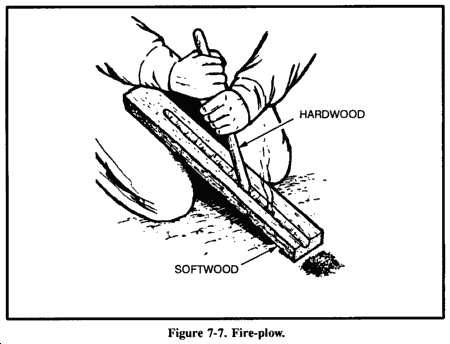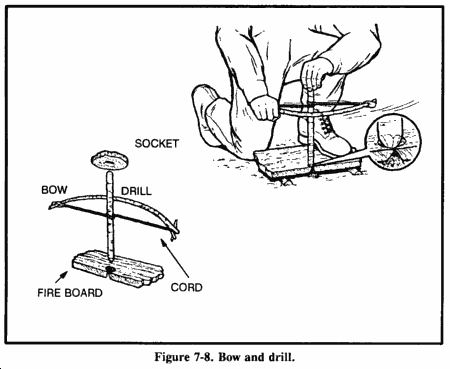|
|
 |
 |
Reply
 | |
Fire starting with items from camping supply or grocery stores.
1. Butane Cigarette Lighter:
OK, OK, not a revolutionary break-through, but it can't be beat and I never leave home without one. Few things are more worthless than an empty lighter!(MAKE SURE THEY ARE FULL) All lighters now have an idiot proof safety mechanism that requires adults to seek the assistance of a child to operate!... IF THE LIGHTER GETS WET ITS NO GOOD FOR HOURS.
2. Flint and Magnesium:
This is a product that has been on the market for a few years now and is an item that I always carry! Its a 3" x 3/4" x 3/8" block of magnesium that has a flint rod molded into the side of the block. It also has a hole in it and comes set up as a key-chain. I keep a police whistle attached to mine in an outside pocket where its ready-to-hand. To use, shave magnesium from one side (of course I don't need to tell you to carry a knife) and collect the shavings. Then with the back of the knife blade, "shave" the flint so that the sparks ignite the magnesium shavings. Have your kindling handy! This heat is intense! But it doesn't last long, so you've got to get right on it with that kindling. It helps if you pile the shavings on something flammable(NOT IN YOUR LAP).
The basics
There are three requirements for fire: fuel, oxygen and heat. Remove any one of them, or provide it in inadequate quantities, and the fire dies. This balance is most critical when the fire is just starting; the heat generated by your initial fire is small, so your fuel needs to be small and the airflow to it must be good.
|
|
 First First
 Previous
2-4 of 4
Next Previous
2-4 of 4
Next Last
Last
|
 |
Reply
 | |
Primitive Methods Primitive igniters are those attributed to our early ancestors. Flint and Steel The direct spark method is the easiest of the primitive methods to use. The flint and steel method is the most reliable of the direct spark methods. Strike a flint or other hard, sharp-edged rock edge with a piece of carbon steel (stainless steel will not produce a good spark). This method requires a loose-jointed wrist and practice. When a spark has caught in the tinder, blow on it. The spark will spread and burst into flames. Fire-Plow The fire-plow is a friction method of ignition. You rub a hardwood shaft against a softer wood base. To use this method, cut a straight groove in the base and plow the blunt tip of the shaft up and down the groove. The plowing action of the shaft pushes out small particles of wood fibers. Then, as you apply more pressure on each stroke, the friction ignites the wood particles. 
The technique of starting a fire with a bow and drill is simple, but you must exert much effort and be persistent to produce a fire. You need the following items to use this method: - Socket. The socket is an easily grasped stone or piece of hardwood or bone with a slight depression in one side. Use it to hold the drill in place and to apply downward pressure.
- Drill. The drill should be a straight, seasoned hardwood stick about 2 centimeters in diameter and 25 centimeters long. The top end is round and the low end blunt (to produce more friction).
- Fire board. Its size is up to you. A seasoned softwood board about 2.5 centimeters thick and 10 centimeters wide is preferable. Cut a depression about 2 centimeters from the edge on one side of the board. On the underside, make a V-shaped cut from the edge of the board to the depression.
- Bow. The bow is a resilient, green stick about 2.5 centimeters in diameter and a string. The type of wood is not important. The bowstring can be any type of cordage. You tie the bowstring from one end of the bow to the other, without any slack.
Bow and Drill 
To use the bow and drill, first prepare the fire lay. Then place a bundle of tinder under the V-shaped cut in the fire board. Place one foot on the fire board. Loop the bowstring over the drill and place the drill in the precut depression on the fire board. Place the socket, held in one hand, on the top of the drill to hold it in position. Press down on the drill and saw the bow back and forth to twirl the drill .Once you have established a smooth motion, apply more downward pressure and work the bow faster. This action will grind hot black powder into the tinder, causing a spark to catch. Blow on the tinder until it ignites. Note: Primitive fire-building methods are exhaustive and require practice to ensure success. |
|
Reply
 | | (1 recommendation so far) | Message 3 of 4 in Discussion |
|
TIP: In areas where no trees are found, such as in the upper plains States, a very good source of fuel is an old dried out cow pattie.....or cow dung. Buffalo dung works just as well.
This is a source of fuel that has a huge amount of surface area to it, meaning that it can easily be ignited with any of the methods you listed above. Since cow dung is composed mostly of undigested plant material, it will easily burn when dry. The large amount of surface area provides an excellent exposure to the air, meaning that blowing on the dung is rarely ever required.
Of course, the greatest advantage to using this source of fuel, is that it is plentiful in such areas, and can easily be gathered and stored for future heating. This is a very light-weight fuel source, but rather bulky. It works great. Just don't try picking up a fresh cow pie!  Look for the ones that are aged to a light gray color, meaning that they are fairly old and well dried out. Those that are ready for the fire pit will likely have many tiny holes in them, which are formed by insects and worms which feed on the cow dung. These holes are actually the beginning a long tunnel, and provide a great source for oxygen to the inner portion of the fuel, ensuring a rather smoke-free burn, with little need to fan the fire. Look for the ones that are aged to a light gray color, meaning that they are fairly old and well dried out. Those that are ready for the fire pit will likely have many tiny holes in them, which are formed by insects and worms which feed on the cow dung. These holes are actually the beginning a long tunnel, and provide a great source for oxygen to the inner portion of the fuel, ensuring a rather smoke-free burn, with little need to fan the fire.
|
|
 First First
 Previous
2-4 of 4
Next Previous
2-4 of 4
Next Last
Last
|
|
|
 Free Forum Hosting
Free Forum Hosting